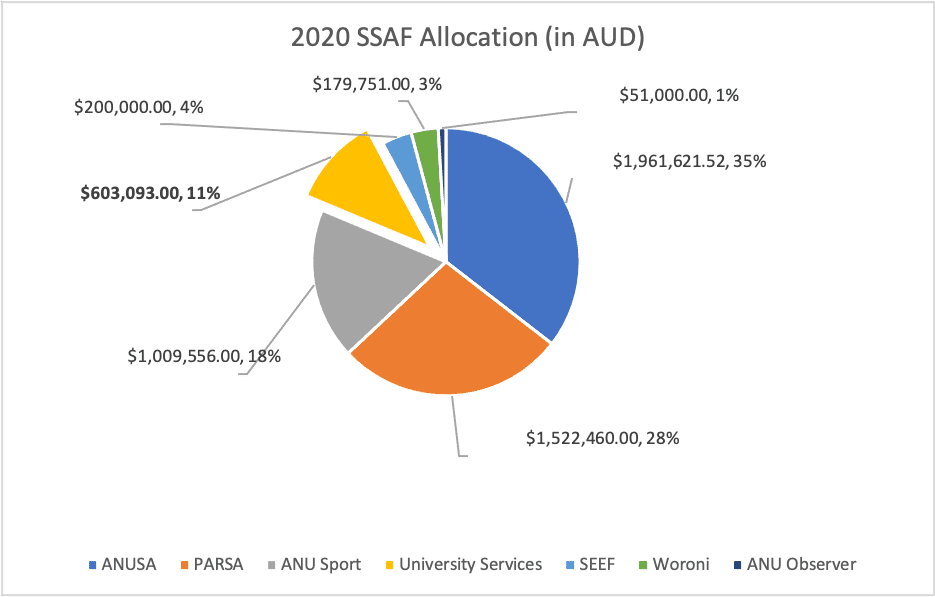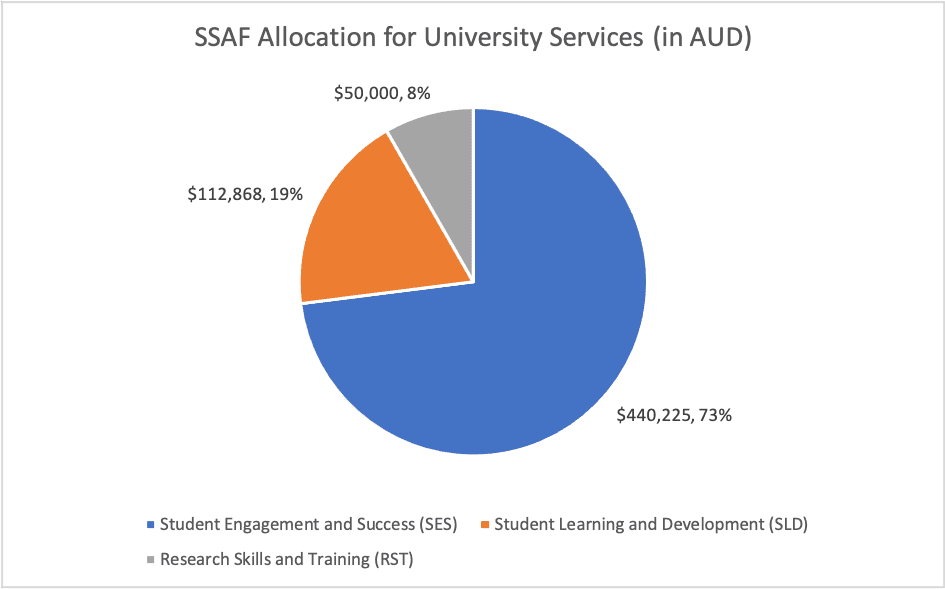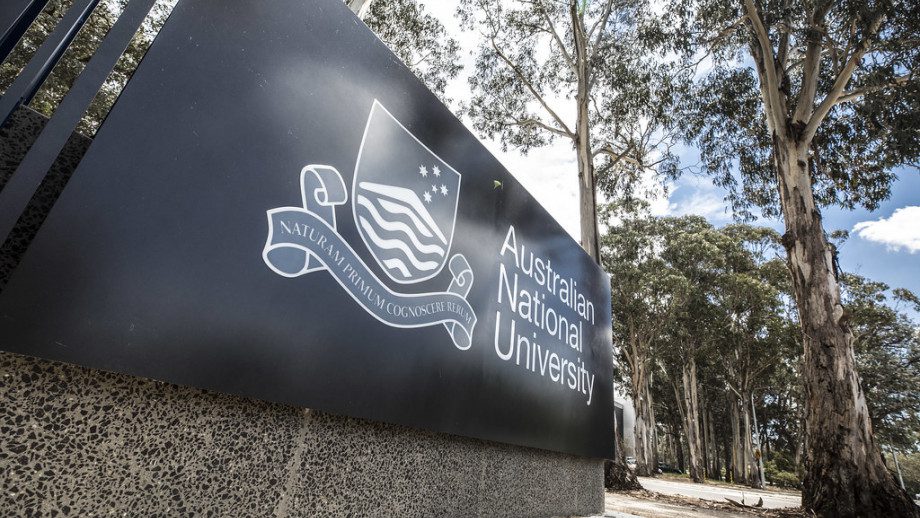If you’ve ever gone to a club’s event to snack on some pizza, snagged a goody bag (or two) during O-Week, or used any services by ANUSA and PARSA, chances are you’ve already paid for it. Every year, full-time and part-time students pay around $300 and $150 as a Student Services and Amenities Fee (SSAF). Pooled together, this fee amounts to roughly 5.5 million dollars that ANUSA, PARSA, ANU Sport, Woroni, ANU Observer, and the University then spend on student services.
University regulations require each student organisation to report how they spend this money. But three recipients, all university organisations, do not have such reporting requirements. The only public information on how the ANU spends over 10% of the SSAF pool are fourteen dot points on the SSAF webpage. Following a Freedom of Information (FOI) request, we now know where the money goes.
The Finances
The three university organisations that receive SSAF income are: Student Engagement and Success, Student Learning and Development, and Research Skills and Training. I derived the figures below from each organisations’ 2020 SSAF bid estimates, mid-year financial updates, and their published allocations. They do not reflect exact spending, as the 2020 finances are only finalised at the start of next year, but they show how the university has allocated SSAF money to these organisations.

Three-fourths of the University’s SSAF funding goes to Student Engagement and Success (SES), totalling $440,225. SES spends around 70% ($305,325) of its SSAF on salaries for ANU staff, with two-thirds of this going to casual student positions, and 30% ($134,675) on program costs. These program costs include SET4ANU ($41,973), Griffin Hall ($28,000), Learning Communities $22,000), Student Research Conference ($15,000), ANU+ ($12,000), ANU Wellbeing Projects ($10,000), and the First Year Experience project ($5,927).

While the FOI documents do not show how SES distributed salaries this year, its 2020 SSAF bid notes an estimated breakdown in salary costs for 2019. Staff allocations include a professional full-time Student Wellbeing Co-ordinator ($122,000) and student casuals for learning communities ($58,000), the Student Research Conference ($42,000), orientation and transition ($17,500), Set4ANU mentoring ($45,000) and ANU+ ($27,498). Additionally, $8,000 was allocated to a Wilson Security bus driver for O-Week airport pick up. The 2019 salary estimates total $322,000, resulting in a $16,675 discrepancy to the 2020 SSAF allocation. In response to an email enquiry, the University did not confirm why there is a discrepancy but noted that there are differences between estimated and actual costs.**
Student Learning and Development (SLD) receives over two-thirds of the remaining amount, totalling at $112,868. SLD uses SSAF money to fund the Writing Centre ($81,868), English Conversation Groups ($15,500), ANU Undergraduate Research Journal ($8,500), and International in Focus ($7000). SLD spends 90% of their funding on student salaries, with the Writing Centre hiring six postgraduate students and the English Conversation Groups hiring three undergraduates. The ANU Undergraduate Research Journal costs pay for an Assistant Editor ($5,200) and cover other copyediting costs. The International in Focus program highlights international career opportunities for students, with SSAF funding covering conference costs.
Research Skills and Training (RST) receives $50,000 for the Thesis Bootcamp Program. In their 2020 SSAF Bid, RST notes the success of the program in helping doctoral students, especially in targeting vulnerable students at substantial risk of dropping out. RST ran this program with PARSA until 2019, when the association cut funding to the bootcamp programs. Due to COVID-19, RST delayed the camps until November and December, but estimates they will spend all $50,000. RST spends 88% of the camp’s costs, totalling $44,000, on catering and other minor items, with ANU Staff volunteering time and taking no salary. RST spends the remaining $6000 on running online journal and thesis writing bootcamps.
The Implications
We should not have to FOI the university to know how it spends our SSAF money. Yet, it is unsurprising that we must. ANU centrally manages the entire SSAF allocation process, with negotiation, bidding and distribution occurring in closed meetings between the University and the bidders. The University’s decision this year to do away with the SSAF bidding and allocate SSAF funding on its own projections is disappointing but not surprising given the overall lack of transparency.
Does the ANU have something to hide? Not really. Prior to 2020, SSAF bidders could scrutinise each other’s bids. The FOI documents do not show any fraud or mismanagement by university bodies. Some of the proposals even address student needs that other organisations have not prioritised. In comparison to most other universities, an 89% SSAF allocation to student-run organisations is exceptional. Yet, a potential reason for the University’s wariness is that transparency brings unwanted scrutiny.
A trip through the Woroni archives will unearth a decade of articles and debates on SSAF expenditure. Every ANUSA election, candidates clash over four-digit SSAF spending. Students regularly scrutinise student organisation budgets, whether through unfair calls to defund them to serious questions over corporate sponsorship. The financial transparency that these organisations provide even allow for in-depth critiques of their financial positions. While a few organisations receive more scrutiny than others, there is at least some scrutiny by students. That is not the case with the University’s spending.
In 2019 ANU Council minutes, the ANU maintains that its current method of consultation is adequate. If a student is not happy with SSAF allocations, they can email dissatisfaction to the relevant university executive. Yet, in a document publishing student feedback to SSAF allocations, the University barely engages with much feedback, with most comments ‘noting’ a response. In contrast, student organisations respond with detailed and empathetic comments. Notably, published responses for 2019 and 2020 are missing. Similarly, in an email inquiry, the ANU confirmed the survey helps guide priorities for SSAF expenditure. But they did not respond to ANUSA’s claims that the survey was irrelevant as SSAF expenditure for 2021 was already pre-set.
The Higher Education Support Act 2003 stipulates guidelines on how the University must formally consult student organisations on SSAF expenditure. In response to ANUSA’s claim of being ‘kicked out of the room’, the ANU stated it underwent several stages of informal and formal consultation with all SSAF stakeholders. The 2020 ANUSA President, Lachlan Day, noted that the ANU changed this year’s SSAF process to address delays in transferring funds and to acknowledge the difficulties of COVID-19. He maintains ANUSA’s position that bidding must take place since that, while the ANU sought feedback, it did not partake in ‘genuine’ consultation.
For 2021, ANU Council is deciding on a new SSAF process to distribute funds. This agenda item, however, was marked confidential. In comparison, the Council publicised the 2019 SSAF process. The 2020 Undergraduate Representative on ANU Council, Lachlan Day, confirmed that Council discussed a new SSAF process for 2021 but does not know why it was marked confidential. He notes that the ANU notified all SSAF receiving organisations and they gave feedback for this proposed process.
Advice from the Department of Education indicates that the SSAF allocation must be ‘transparent in process; visible; and consultative.’ Yet, this year we have seen no bidding, a pre-set allocation, and accusations of improper process by our student association. Even prior to 2020, the University showed signs of greater opaqueness over the SSAF process. The secrecy surrounding the new 2021 process and the lack of public information only further strains trust in what should be a fair process. In response to COVID-19, The ANU has shown it can be open and transparent with its finances. This should extend to the SSAF allocation.
The University needs to open its books to the same standard that it asks student organisations to. The SSAF ‘consultation’ cannot be pre-determined and should go beyond a student survey, publishing the proposed bids and inviting public submissions from the student body. Students deserve the right to question university organisations over SSAF expenditure and receive a fair and considered response. Without full transparency and democratic oversight over our student contributions, the University’s SSAF budgets risk inflating to levels found at other universities. It is up to us to make sure that does not happen at the ANU.
* I derived the number of casual student employees from the 2020 SSAF bid and the 2019 estimated salary expenditure. The University did not specify if this was correct in response to my email enquiry.
^ I used 2019 salary proportions as, while not exact, they are unlikely to massively differ to 2020 salary proportions. The University did not specify the 2020 salary proportions in my email enquiry.
**Editor’s note (24/12/2020): An earlier version of this article listed incorrect salary figures of ANU staff. This article has since been amended to correct this. We apologise for this error.
Kai Clark contested the position of Undergraduate Member on ANU Council (UMAC) in 2020.
We acknowledge the Ngunnawal and Ngambri people, who are the Traditional Custodians of the land on which Woroni, Woroni Radio and Woroni TV are created, edited, published, printed and distributed. We pay our respects to Elders past and present. We acknowledge that the name Woroni was taken from the Wadi Wadi Nation without permission, and we are striving to do better for future reconciliation.
